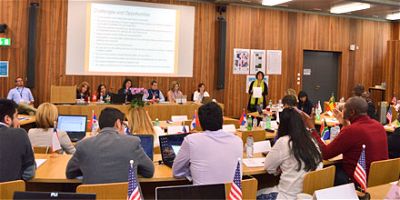
On the Road: Learning from the Successful Swiss Apprenticeship System
May 29, 2018
At a Glance
During its Summer Institute, the Swiss Center on the Economics and Management of Education and Training Systems shed some light on what makes the Swiss apprenticeship system so effective.
Participants from around the world presented at the CEMETS Summer Institute in Switzerland this past June.
Recently, I travelled to Switzerland, a global leader in developing strong apprenticeship and work-based learning systems. I attended a 10-day intensive Summer Institute led by the Swiss Center on the Economics and Management of Education and Training Systems (CEMETS) at ETH Zurich, the leading research university in the country. The training is designed to help other countries learn about the Swiss apprenticeship system and prepare their own reform initiatives. This is the first blog in a three-part series exploring the Swiss apprenticeship system and highlighting lessons that can inform our efforts at home.
The Summer Institute at CEMETS
I was lucky to join the Summer Institute for the second time as a guest faculty member. But I was really there to learn about the apprenticeship plans and challenges facing the 50 participants from countries as far apart as Nepal, Benin, Serbia, Costa Rica, South Africa, Chile, and Colorado and Washington in the United States. CEMETS develops participants’ knowledge through visits to apprenticeship learning and working sites; lectures by researchers and theorists; case studies of the current state of Swiss Vocational and Professional Education and Training (VPET); and participants’ plans for reform and improvement.
I was also eager to hear Dr. Ursula Renold, the director and founder of CEMETS and head of the Division of Comparative Education Systems Research at ETH Zurich, and her colleagues’ most recent research on VPET and visit sites where young people are working and learning. Meeting confident, well-trained young people in a variety of productive work roles inspires visitors to return home energized to build their own talent pipelines of young professionals.
Previously, Dr. Renold worked at the Federal Office for Professional Education and Technology, with her last seven years there as director, and had a major role in modernizing VPET. She also helped several JFF staff explore how some features of the Swiss system could be adapted for the Pathways to Prosperity Network, a national network of states and regions building college and career pathway systems in the U.S.
What is VPET and How Does It Work?
VPET educates 71 percent of Swiss students who attend upper secondary school (the equivalent of grades 10 through 13/14 in the U.S.). It supports teens in their transition to adulthood and careers, boosts economic productivity by providing a pipeline of well-educated young professionals with fresh ideas, and keeps youth unemployment in the single digits. Notably, the Swiss system has no dead ends––young people can switch professions as well as transfer between academic and vocational programs. Indeed, the permeability of the system is one of its greatest strengths. Students readily take advantage of the additional further education and training options within VPET, in universities of applied sciences, or even in traditional universities if they are willing to do the required entry-level coursework. CEOs of Switzerland’s global corporations are as proud of their apprenticeship years as they are of their advanced degrees. VPET is the preferred way to enter banking, insurance, engineering, nursing, information technology, and even dance. And the Swiss have designed a system in which nearly every young person has a place in the economy.
Employer organizations co-own the system with the state and the cantons (regional governmental entities) constituting what are called “social partners.” About one-third of Swiss companies take apprentices. Companies range from Swisscom—the country’s dominant telecommunications entity—to small rural carpentry outfits, to nursing homes, to banks. Openings are demand-driven: a teen must have a signed apprenticeship contract in order to participate, and companies only open apprenticeships to meet their human resource needs. Apprentices work two to three days a week for three or four years, spending the other hours in school and/or in a sector-based intercompany training course where they learn the basics of an occupation or field—the knowledge common, for example, for banking, health care, or construction.
Youth are paid a stipend of between $800 and $1,400 a month by the company, but, since they rapidly do productive work, companies regain their investments plus several thousand dollars more by the end of the three-to-four-year training period. Companies also retain most of the trainees who wish to stay. Having had a major hand in designing their learning, companies hire the young workers who “wissen, konnen, and machen” (learn content, methodology, and social and behavioral skills), as young people will tell visitors. What can’t be easily captured in a brief overview are the intangibles such as:
- Middle-aged employees’ pride in their apprentices
- Pedagogical approaches designed with the best learning science in mind
- Employer associations that take collective responsibility for the training they provide
- Scaffolding that starts in middle school so that youth can experience workplaces and explore their interests
Diving Deeper into VPET
Now that I’ve briefly described Switzerland’s exemplary vocational education and training system, I will next spotlight two companies’ apprenticeship programs and then explore the unique role of sector-based associations in upcoming blogs in this series.
To learn more, view the following resources:
- CEMETS Summer Institute
- Swiss Education System Facts and Figures
- Gold Standard: The Swiss Vocational Education and Training System (Nancy Hoffman and Robert Schwartz, 2015)
Related Content

C-Town Pathways
What do you get when you cross a global software giant with a Boston high school? The next generation of STEM professionals, innovators, and entrepreneurs ready to change the world. Today’s high school students need…

Pathways to Prosperity
We are boldly reimagining how U.S. education and workforce systems meet state and regional talent needs and prepare young people for careers. We are boldly reimagining how U.S. education and workforce systems meet state and…